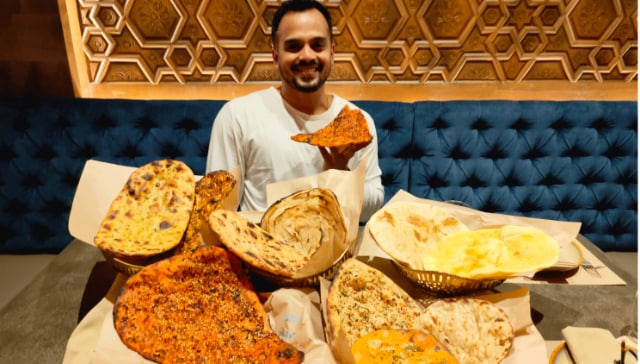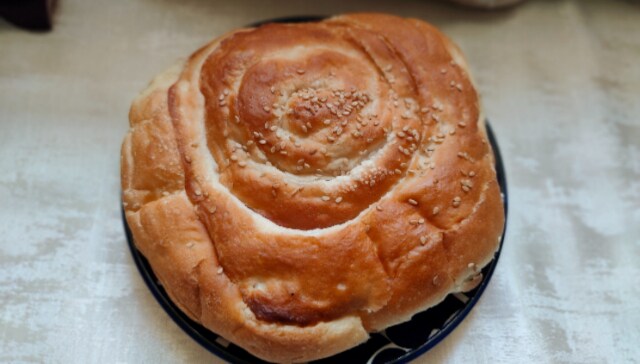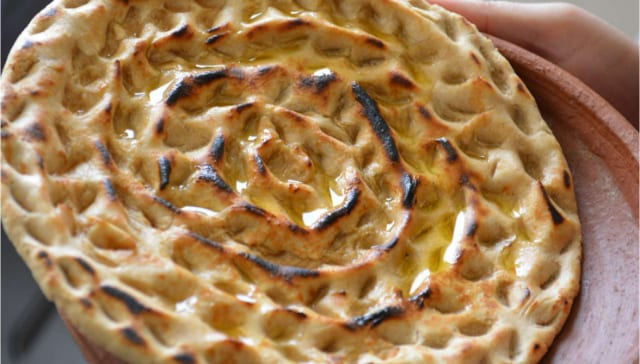Food Friday | India's bread lovers have every knead to celebrate
Food Friday | India's bread lovers have every knead to celebrate

It’s said that if you want to learn about a country, eat its food. And bread is perhaps the best example of that. For, India’s diversity is beautifully represented by its breads, that simple staple, made fresh and hot in big cities, small towns and villages. Culture and tradition thrive here, in age-old kilns, with generations of bread makers bringing their skill and love to the table. And the luckiest get to try that first-hand. Unaez Quraishi, country sales head at an IT company, whose work takes him across the different states, shares. “I’ve eaten practically every Indian bread that there is out there and I cannot compare eating a piping-hot khameeri roti in the lanes of Jamia, buttermilk naan and garam makki di roti on a cold winter day in Chandigarh, the flaky Malabar parotta I had in the South or roth from Pune, with anything else; they should be on every traveller’s list.” Culinary expert and consultant chef, Reetu Uday Kugaji, agrees. “A quintessential part in our everyday lives are Indian breads. The vast repertoire is a treasure that must be passed on from one generation to another, so that the artistic, authentic breads of India – their flavours, standard recipes and techniques do not fade away.”
Around the country on a plate of bread

Restaurateurs with a passion for breadmaking are the torchbearers in keeping this tradition alive. Pankaj Gupta, founder of Taftoon, who has based his restaurant after his love for the Kashmiri ‘taftan’, can take you on a complete trail of India via the tastes and traditions of bread. He says, “In earlier times, as bread travelled around the Grand Trunk Road and found place in Lucknow, Punjab, Delhi and Kolkata and the rest of the country and today, we cannot imagine any Indian food without it. Kashmir has such a rich culture when it comes to local breads prepared in the khandur (bakery) – from the bakarkhani to girda and taftoon and we have three ovens for them as each requires a different temperature and each is so unique. The bakarkhani is saffron-laced, kneaded with milk and topped with poppy seeds, the girda is similar to the naan you get in Mumbai. When making it, bread makers always put their nail marks into it, the idea being to make sure the bread does not puff up due to the steam to become a pita bread. Punjab has a dedicated bread story, famous for laccha paratha and kulcha. We prepare the signature laal naan, with nuts and a specially-aged chilli oil. Khameeri roti, a thinner and softer roti from Uttar Pradesh is known as sourdough in the Western world and yet this is the same science to making it that we had ages ago. From UP, you have besan ki roti, made with roasted gram flour, which is apt for those who do not like gluten. Another rich delight from Lucknow is the ulte tawe ka paratha, which tastes like cotton candy in your mouth, but it is quite heavy, due to the ghee and saffron that goes into it. Go towards Bengal, you have the popular Radhaballabhi luchi, stuffed with dal and spices and eaten with anything from dolma curry to cholar dal and daab chingri. The Hyderabadi version of lucha goes well with haleem.”
And what would be his favourite among them all? “Undoubtedly the Kerala parotta, it’s among the top 5 breads I have eaten in my life,” he says.
Dilli has its own bread charm

In the Capital, in the labyrinths of old gallis, lies a thriving bread culture. Recalls Chef Vidushi Sharma, “If it’s one thing Delhi loves as a city, it’s carb-heavy food and breads are central to every meal in the household. It’s also influenced by cuisines from different parts of India where you are in Old Delhi replete with bakarhanis and sheermals or khameeri rotis in the bylanes of Jama Masjid or the nagori and puri or kachoris of the katras in Chandni Chowk, moving to legendary Mughlai restaurants that ace the tandoor fare. One such naan in North Delhi is the chur chur naan, flaky, crisp and the hero of the show with a side of condiments! Whether it’s the tandoor version with a myriad of toppings or the fermented kind, thin with specks of coriander served at possible every junction with spicy matra, a favourite evening snack, Delhi is rich with all varieties of bread, fermented, fried, charbroiled or just heartily cooked on a tawa like an aloo paratha, glazed with a generous dollop of white butter!”
Pao to litti: Packing power in size

The smaller breads are big on taste, too! Any trip to Goa is incomplete without eating the poee, a bread that is considered an ode to rustic life. Catherina Baretto of Canacona, Goa, shares a lovely nugget around it and says, “We wake up in the mornings to the sound of the poder (breadmaker) delivering poderacho bol for breakfast. It’s prepared with flour, yeast, cardamom powder, sugar, ghee and salt. And when he hands it to us he says, ‘Dev boro dis dinv (God give you a great day).”
In Mumbai, the pao is found in every galli and nook. Chef Anees Khan states, “The city’s old bakeries and community khanawal (local eateries) serve a variety of traditional unleavened and leavened breads like pao, brun paav, bhakri and sweet buns, but pao is the most versatile of the lot. It’s spongy and extremely light in texture due to the hydration of extra water in the dough and goes very well with egg bhurji, misal and any gravy.”
Home chef Rachna Prasad loves making litti, the traditional Bihari delight. She says, “This ghee-drenched wheat ball dish is a popular Bihar and Jharkhand cuisine. Litti is stuffed with a spicy sattu mixture and served with chokha (charred brinjal, potatoes, and tomatoes). It has high nutritional value.”
When bread gets an artistic touch

One of the prettiest of breads is the khoba roti from Rajasthan, requiring patience and precision in its making. Informs Reetu Uday Kugaji, “This bread is just mesmerising, I call it a work of art. In Marwari, khoba means cavity. The thick flat bread is made with coarsely ground whole wheat flour to which salt and desi ghee is added. It is cooked on a tawa and after it is 1/4th done, impressions are made into it by pinching that side of the roti. It’s then further cooked on a chulha and smeared with desi ghee. This roti is travel-friendly and has a long shelf life, just like the methi thepla.”
Indian tandooriyas or bread makers are a diminishing lot, today
Today, when you step into an Indian eatery anywhere, the meal won’t be complete without a choice of breads, yet the breadmaking is an underrated skill here. Says Pankaj, “Anyone can make a sourdough, but I challenge anyone to make a tandoori roti as easily. Just put your hand into the scorching-hot tandoor and you realise how tough it is. The tandooriyas are one of those breeds that are diminishing and at such a fast pace. I find that many of these people do not want their kids to take to the trade as their work is so tough. They have burnt hands, with hairless arms (as the hair is singed and burnt due to the heat while working with 45-degree tandoors for over 10 hours a day). Their work happens only because of their skill that is passed down from generations.”
The restaurateur sums up, “If you ask me, the bread game goes to the north of India hands down. And it’s not just us, the world is recognising it; naan is in the dictionary now and if you visit any supermarket in the UK, it’s impossible not to find naan or kulcha. Yet, the breads we have eaten are just 15 percent of it all; there are so many jewels out there that are still untouched.”
Ismat Tahseen is a Mumbai-based journalist who writes on food, trends, culture and lifestyle for over a decade now.
Read all the Latest News, Trending News, Cricket News, Bollywood News, India News and Entertainment News here. Follow us on Facebook, Twitter and Instagram.
What's Your Reaction?



























































